Eight years and two generations – that’s how long the BMW 3-series has been in India for, and for all of that time, it has proven to be the best car in its segment. The new ‘F30’ 3-series that was introduced in 2012 was particularly impressive, and easily set the new standard for the segment with a far wider cache of abilities than ever. But then this new Mercedes C-class, the ‘W205’, is something really special, and even after just a short first drive, it really blew us away. It’s not without its flaws, of course, but even so, we think it has a really good chance of finally dethroning the very talented BMW. And this comparison test just wouldn’t feel complete without the third German, now would it? It’s now the oldest car here by some margin, but in its latest guise, the Audi A4 is more powerful and better-equipped than it was when these three last met.
Speaking of which, back then in 2012, things were a bit different from what they are today. The prices of these cars – even in the top spec – were nearer to Rs 30 lakh than Rs 40 lakh, which is around what they are now. And thanks to the rise of the new ‘compact luxury’ segment, the equations have changed for these three, which have been pushed to make a better case for themselves overnight.
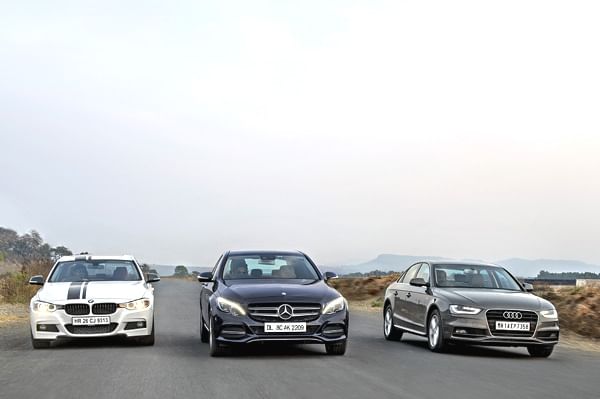
Looking class
And here’s where the C-class immediately strikes the first blow – its regal new look shouts out that it’s no longer the ‘entry-level’ Merc and that it is very closely related to the S-class flagship. Mind you, all these cars have their own intra-brand family resemblance, but it’s Mercedes’ new styling language, though not to a Merc purist’s tastes, that to most eyes conveys a look of luxury best.
Our 3-series test car may look like an extra from a Fast and Furious movie set, but that’s because it’s been draped in BMW’s full range of optional M-Sport accessories. The standard 320d Sport trim has classier-looking bumpers, smaller 17-inch wheels and does without the skirts, spoilers, carbon-fibre trim and racing stripes. It’s a well-proportioned, sporty and handsome sedan, but it simply lacks the wow factor of the new Benz.
The A4 also lacks that wow factor, but its neat, business-like lines are more discreet than either of the others, and like a good suit, that subtle simplicity has its own kind of appeal. Its inoffensive look gives it a broader reach than the others, but it also runs the risk of looking a little too anonymous and ordinary.
Art and craftsmanship
If the C-class’ exterior wasn’t enough to get your attention, its interior definitely will be. Here too, there is a tendency among luxury carmakers to follow a fixed template across their model range – but the C-class does not. Perhaps it’s setting the template for future models, but it looks different from the S-class cabin, and has a character all of its own. It does borrow a few bits – door handles, switches and knobs – from the S-class, but that just points at the quality level Mercedes was going for. The wood looks rich, the leather is double-stitched, and the metal bits feel like they’ve been carved with laser precision. If there’s a letdown, it’s the dials, which look like they belong in a mainstream Japanese sedan and don’t fit in with the luxurious ambience of the C-class. The other thing you might have to watch out for is the pale shade of beige that covers the lower half of the cabin – it’s bound to pick up stains from wayward feet quite easily.
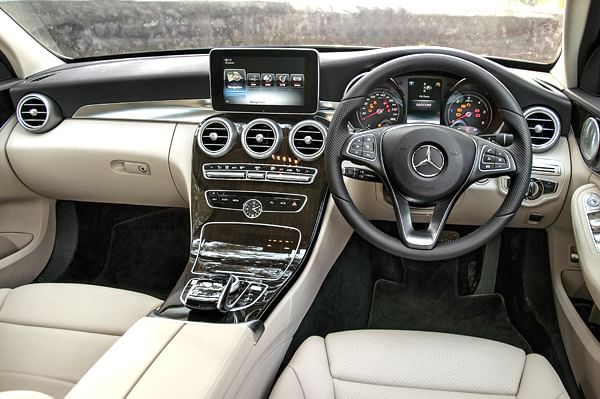
Now it’s not necessarily a bad thing that the BMW and Audi stick to a family formula for their respective interiors – both are logically laid out and hold many functions; it’s just that they don’t feel quite as special as the Merc’s. In Sport Line trim, the BMW gets a black dashboard with brushed silver panels, and red accents and stitching. Personally, we’d opt for the Luxury Line trim, which is upholstered in beige leather, dark wood and brushed chrome, and looks a lot more elegant. The build is quite solid in the cabin, but the material quality could be better. In the A4 as well, you can’t really find too much fault with the fit and finish when you see it in isolation. It’s just that, alongside the new C-class, it feels a bit dated. It has to be said that the Audi’s cabin is still very practical and things like the clear, attractive dials and generous stowage spaces are still its highlights.
The other area where Mercedes hasn’t held back – at least for now – is the equipment list on this fully loaded Avantgarde variant. You can also opt for the lower ‘Style’ trim, which isn’t as well-equipped and misses out on the panoramic sunroof (it still gets a normal one though), multi-colour ambient interior lighting, the rear power socket, keyless go, satellite navigation, along with some of the chrome trim on the exterior.
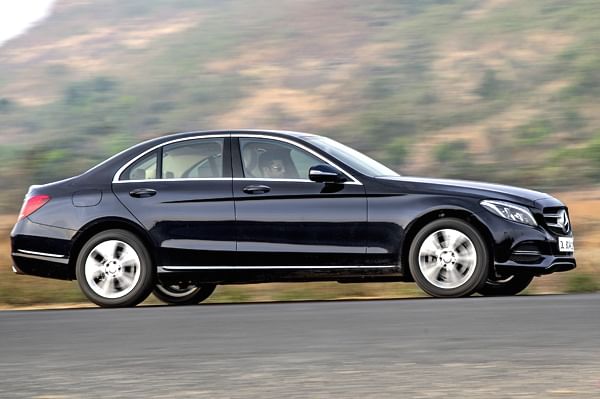
Because the diesel C-class is a full import (and heavily taxed) for now, it comes with a high price, and so Mercedes has tried to make it feel like it’s worth every last lakh. It’s not even just the obvious things, like the new, high-res 7-inch colour screen, or the configurable LED ambient lighting or the touchpad controller. There’s also subtler stuff you’ll notice later, like electric adjustment for the steering, thigh support and headrests, a two-pin socket for your laptop charger, and seatbelts that ‘hug’ you reassuringly after you click them in. It’s worth noting though, that some of the kit on our test car – the excellent Burmester hi-fi audio and the front seat memory function, for example – are not part of the India-spec equipment list.
It’s not that the other two are poorly equipped, it’s just that Mercedes has gone all-out. The BMW and Audi both get dual-zone climate control, onboard computers with screen-based interfaces (the Merc has the biggest screen), a sunroof (single, versus the Merc’s panoramic one), Xenon headlamps with LED daytime-running lamps (the Merc has full LED headlights), high-fidelity audio systems and good smartphone integration. However, the BMW misses out on a few things even the Audi gets, like front parking sensors, a rear-view camera and satellite navigation. The 3-series is also the only one that comes with a manual handbrake rather than an electronic one.
Conference room
The C-class and A4 perch you at a comfortable height in their driver’s seats, and fiddling around with their electric seat controls will find you a comfy position easily. Visibility out of both cars is really good too and you can get used to their dimensions quite easily. The 3-series, on the other hand, has really low-set seats. It works well towards delivering BMW’s characteristic sporty driving experience, but if you’re not very tall, it’ll take a little while to get comfortable with where that long bonnet ends, even with the seat raised all the way.
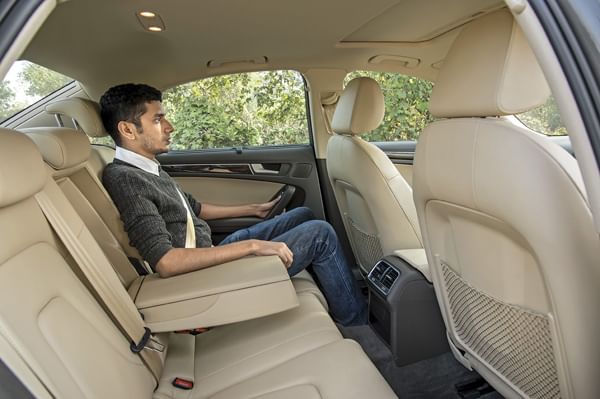
The low seating position extends to the rear of the 320d as well, and you have to lower yourself into it more so than the others. Once you’re in, however, this is the most comfortable seat of the lot – a crucial point scored for the Bimmer in this segment, where owners tend to be chauffeur-driven. The 3-series offers the most room, thigh support is good and the seat is really well-cushioned too.
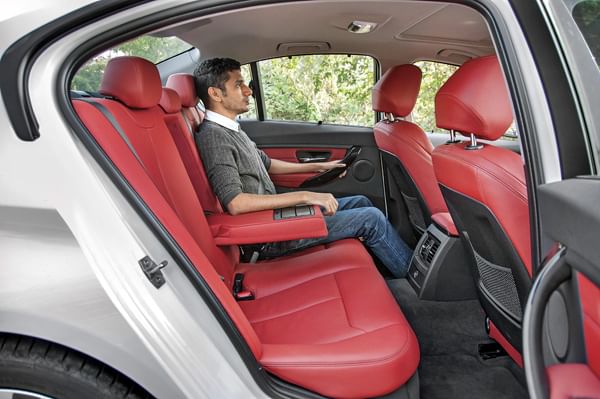
And this is where the new C-class takes a serious hit. Though legroom is in generous supply, headroom is a little tight and the firm and heavily contoured cushions nudge you towards the centre of the bench. Most of all though, the seat squab is just too short, and this leaves your legs insufficiently supported. It’s a big shortcoming in an otherwise brilliant cabin.
The A4 too is a little short on thigh support, but it does fare better than the C-class, and its seats are a little more comfortable too. However, it loses out on outright space, particularly kneeroom.
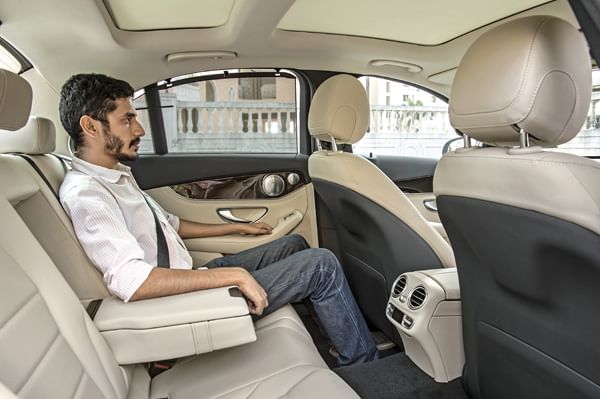
While all three cars have large and well-shaped boots, it’s each company’s policy on spare tyres that comes into play here. The Audi offers a space saver that’s neatly tucked into a compartment beneath the boot floor, so it doesn’t affect luggage room. The C-class’s spare sits on the boot floor, and so severely impacts storage space. BMW doesn’t give you a spare wheel at all – a bad idea, given our poor roads – but these days, you are able to purchase a space saver from the dealer, in which case, like the Merc, it will sit in the luggage area.
Forward push
The C-class diesel is currently only being offered in ‘220 CDI’ specification, with no immediate plans for the twin-turbo ‘250 CDI’ version. That means its 2.1-litre, four-cylinder diesel engine produces 168bhp and 40.78kgm of torque, which compares quite favourably here. The other two do have a slight power advantage, the BMW and Audi’s 2.0-litre motors producing 181bhp and 174bhp respectively, but the C 220 CDI produces about 2kgm more torque than either of them. The Merc’s peak torque also comes in about 300rpm sooner, which is evident in the way it delivers its power. The oomph comes in low down, and surges strongly through the mid range. Keep the revs in this vital zone and you’ll never feel short on power, even for overtaking. We wouldn’t advise stretching it near its redline, however, as it will feel noisy and strained. What’s more, pushing this motor too hard also brings out the shortcomings of the 7G-Tronic torque converter gearbox, which can fumble with its shifts when you ask too much of it.
The 320d’s motor serves up performance in a way that befits its sporty chassis, but which doesn’t work so well in cut-and-thrust traffic. Rather than an even surge of torque, the delivery is rather urgent and peaky – great when barrelling up a mountain road, but requiring very careful throttle modulation when setting off from traffic lights. No complaints about the eight-speed gearbox though, which is smooth, quick and obedient in just about any condition.
The A4’s CVT works best in traffic, where coupled with the refined engine, it does a fine job of getting you through your daily commute. The linear power delivery makes the A4 the smoothest to drive in rush hour. The CVT has eight artificial ‘ratios’ that you can shift through, but it’s best just to let it do its own thing, and not push it hard. Doing so will expose you to the CVT’s typical ‘rubberband’ effect, where the engine becomes all revs and no acceleration. The Audi engine is the quietest of this lot in just about any situation, though we were pleasantly surprised to find how refined the Mercedes engine was – it’s been more vocal in older Mercs. The BMW diesel, sadly, makes an annoying grumble at idle, which only intensifies as you build up the revs. Still, be it in kickdown overtaking or outright acceleration, the 320d was the quickest of the three in our performance tests, but at least till 100kph, the C-class came quite close.
All these cars have selectable driving modes that adjust the engine, gearbox and steering behaviour from lighter, more economical modes to sharper sports modes – and in the C-class and 3-series, we found the ‘Sport+’ settings a little too eager. However, all cars have fixed dampers, so the suspension is unaffected by these modes. The BMW and Mercedes also get engine stop-start to help save fuel.
Ups and downs
Two of these cars have had their suspensions set up at opposite ends, while the other finds a comfortable balance in the middle; care to guess which is which? The A4 has a pillowy soft ride which, at low speeds, just isolates you from everything you roll over. It’s perfect for primarily urban use and, for most practical purposes, is the most comfortable of all with its ability to mute expansion joints and sharp edges. However, as you might imagine then, the Audi feels mushy on the highway, especially over undulations; show it a corner and there’s loads of body roll. The steering too, though light and effortless, feels a bit numb, which really drives home the fact that this is a car meant to isolate you, not engage you in the driving experience.
The C-class also has very light steering, but it’s quick and quite accurate, with a good amount of feel too. As a result, it’s a joy to point that star on the nose into tight corners, and the whole car feels very light and agile, despite being the heaviest here. In raising the India-spec car for better ground clearance, Mercedes has stiffened up the ride, and it really shows at low speeds.
The car is decidedly stiff-kneed over sharp edges, the ride is quite brittle. On an uneven road, passengers will feel short, sharp vertical movements in the cabin – the very opposite of the A4 experience. Likewise, speed things up and it settles down impeccably. It has a flat and consistent poise on the highway and exhibits very little roll around corners. Ironically, it’s the Merc that begs you to drive faster.
So the BMW is the one that finds a good middle ground. It takes low-speed bumps well and yet manages to keep its composure at high speeds. There is a bit of a thunk through sharp-edged bumps, but we put that down to this car’s optional 18-inch wheels. However, it exhibits some very un-BMW-like body roll around corners – not as much as the A4, but more than the C-class – and the weighty steering has an odd looseness around the centre position. However, the overall balance of the chassis and the fluidity with which it changes directions makes it really fun to drive, especially with that motor.
A whole new world
This segment isn’t what it used to be and is no longer the entry point to these luxury brands. To make space for the new crop of compact luxury cars, the no-frills base models in this segment are fast vanishing and the luxury quotient is on the rise. Just look at this A4 Technology trim – it’s more expensive than the previous top trim, but equipment that was once optional is now standard; such is the way this segment is evolving. The Audi makes a great car if you use it mainly in the city, with its cushy ride, smooth powertrain and light controls. What’s more, you can get some good deals, which makes the A4 great value. But there’s no escaping this car’s age – the A4 looks and feels a bit dated now.
The 3-series is a superb all-rounder which manages to do almost everything well, or well enough at least. It’s spacious, has the best back seat, rides well and it’s also really enjoyable to drive, which gives owners the best of both worlds. But with the game moving forward, that’s clearly not enough. There needs to be a certain wow factor, in the styling, interior design and quality, or equipment, which the Bimmer falls short of. However, there’s a facelifted 3-series just around the corner, and we think the changes it will bring could even the odds a bit more for the BMW.
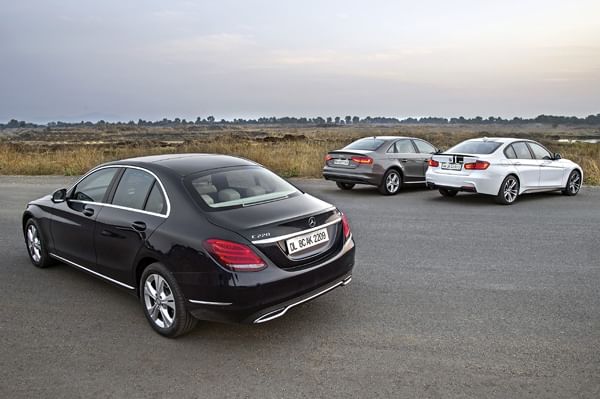
The fresh new C-class wins this test. No doubt it is more expensive than the other two (but not by much), and in some states, high registration charges for CBUs mean it will work out even pricier on road. Then there’s the back seat, which isn’t as plush as it should be, and the hard-edged ride which is quite un-Merc like. But then you think about how much has been packed into this car and it’s clear that Mercedes is reshaping the segment – moving it higher up. Of course, when local assembly of the C-class diesel begins later this year, the price will go down and with it, some equipment will be removed too, though if the locally assembled petrol version is anything to go by, it will still cost north of Rs 40 lakh. For now, however, the high water mark has been set. There will be updated cars as well as brand new ones coming to challenge it in the coming year, but until then, the new C-class is the new segment benchmark.





Comments
Member Login
Personal Details
No comments yet. Be the first to comment.